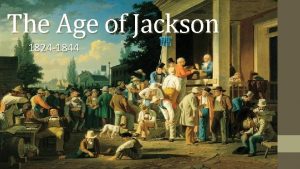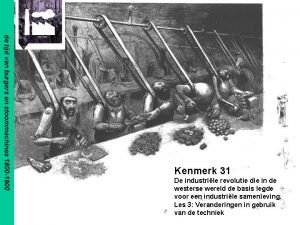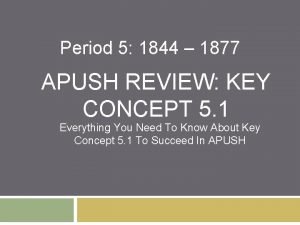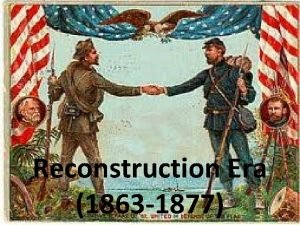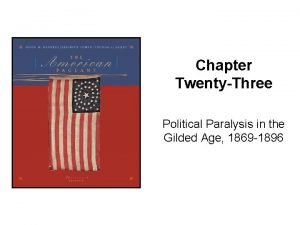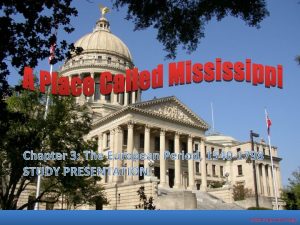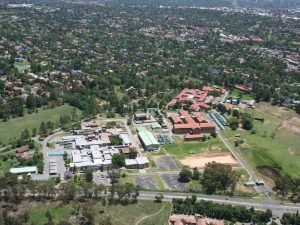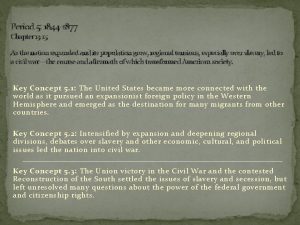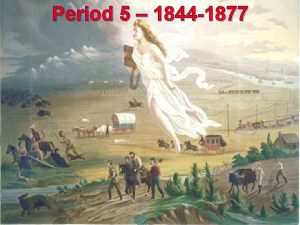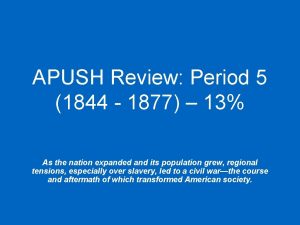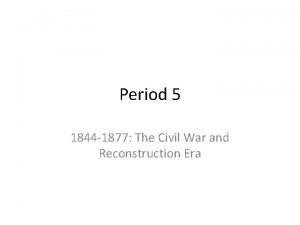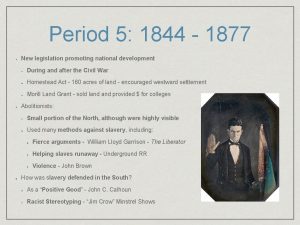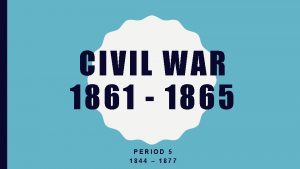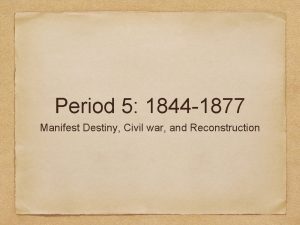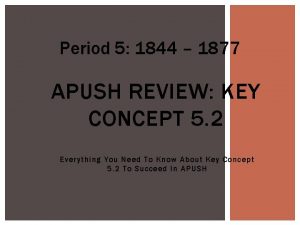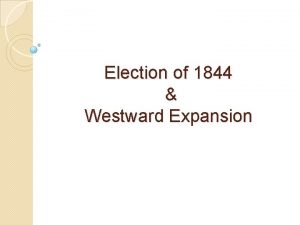Period 5 1844 1877 Chapter 13 15 As












































- Slides: 44

Period 5: 1844 -1877 Chapter 13 -15 As the nation expanded and its population grew, regional tensions, especially over slavery, led to a civil war—the course and aftermath of which transformed American society. Key Concept 5. 1: The United States became more connected with the world as it pursued an expansionist foreign policy in the Western Hemisphere and emerged as the destination for many migrants from other countries. Key Concept 5. 2: Intensified by expansion and deepening regional divisions, debates over slavery and other economic, cultural, and political issues led the nation into civil war. Key Concept 5. 3: The Union victory in the Civil War and the contested Reconstruction of the South settled the issues of slavery and secession, but left unresolved many questions about the power of the federal government and citizenship rights.

Chapter 13 The Impending Crisis 1840 -1860 Between 1845 and 1860, critical events and issues seemed to come in a rush, giving Americans little time to analyze what was happening and to reflect on long-range solutions. Emotion seemed to replace reason, as the debate grew increasingly repetitious and loud. The question, or so it seemed, was the expansion of slavery into the territories gained during the Polk administration. But something far more fundamental was at stake, the future of the nation. Northerners had become convinced that the expansion of slavery threatened the democratic foundations of the United Sates and that expansion would give the South control of the government, which would lead to economic stagnation, unemployment, and financial ruin, all the effect of the depression of 1837 but magnified. From their point of view, the South, and its peculiar institution, threatened the nation's growth and progress and had to be overcome. The South, however, convinced of the legality of its position and the validity of its institutions, fought back and with remarkable success. By combining its power in the Democratic Party (which gave it extraordinary influence in Congress and with the president) with its supporters on the Supreme Court, the slave states seemed secure. But still, they were fearful. Convinced that they had given up all they could in earlier compromises, they feared future gains by those they considered to be enemies, and those they feared most were the Republicans.

The Impending Crisis 1836 -1860 Chapter Thirteen Main Themes üThe influence of Manifest Destiny on Americans during the period, and how it shaped American policy in Texas, Oregon, California, and the Southwest. üThe many events concerning the expansion of slavery into the western territories that deepened divisions between the North and the South and led to the Civil War. üThe effect of the dispute over slavery in reshaping the American political-party system, bringing an end to the Whigs and birthing the Republicans.

Chapter 13 The Impending Crisis 1830 -1860 Manifest Destiny John O’Sullivan Stephen Austin Texas Revolution Sam Houston The Alamo Battle of San Jacinto “ 54 40 or Fight” Oregon Territory Oregon Treaty 1846 James K. Polk Election 1844 John Slidell Zachary Taylor Mexican Cession Wilmont Proviso Popular Sovereignty Free-Soil Party 49’ers Compromise of 1850 Fugitive Slave Act personal liberty laws “Young America” Ostend Manifesto Gadsden Purchase Kansas Nebraska Act Republican Party “Bleeding Kansas” Sumner-Brookes Affair Dred Scott v. Sanford Stephen Douglas Lincoln-Douglas debates Lecompton Constitution James Buchanan John Brown Harpers Ferry Abraham Lincoln Election 1860 Southern Secession Ft. Sumter, SC 1861

Oregon Trail 1830 -1850

Chapter 13 The Impending Crisis 1830 -1860 Discussion notes

Chapter 13 The Impending Crisis 1830 -1860 Discussion notes

Chapter 13 The Impending Crisis 1830 -1860 Discussion notes

Mexican War 1846 -1848

Civil War 1861 -1865 Chapter Fourteen Main Themes üThe establishment of the Confederacy, the failure of the final attempts at compromise, and the road to Fort Sumter. üThe social and economic mobilization of both the Union and Confederacy for war, and what that mobilization revealed about the nature and character of each side. üThe military strategy and campaigns of the Civil War, leading to the Union victory in April of 1865.

Chapter 14 The Civil War 1861 -1865 Before 1860, reference to the nation generally began "these United States are, " but after 1865 it became more frequently "the United States is. " In that change, one might well see the most important outcome of the American Civil War. The question of the nature of the Union, which had been debated since its inception, was settled; the nation was one and indivisible. As such the United States joined a worldwide movement to create large, consolidated nation-states. The cost had been great, in both human and financial terms, but the war had done more than defeat secessionist rebellion. It had set the nation on a new course. States’ rights, as an alternative to nationalism, had been dealt a fatal blow. The tariff and internal improvements were law and would remain so. Slavery was abolished, free labor was triumphant, and industrial growth and material progress seemed to lie ahead. The war, therefore, represented more than a victory for the armies of the Union. The real victor had been the Union itself. Never again would the supremacy of national laws be seriously questioned. The Civil War gave birth to the modern United States. Indeed, it ended an era and began another.

American History: Chapter 15 The Civil War

The Secession Crisis � December 20, 1860 – South Carolina convention voted to secede � 6 others followed by March 4, 1861 � Buchanan did little to stop secession in his lame-duck period � Crittenden Compromise: � Proposed new Constitutional Amendments: � Guarantee slavery where it was; re-establish MO Compromise line in all US territory (where it was in 1860 and the future) � Republicans (Lincoln) did not support the plan � A key part of their platform was the non-extension of slavery � Fort Sumter: � Confederate leaders ordered the capture of the fort (SC) � April 12, firing began, on the 14 th, the fort surrendered � As Lincoln mobilized for war, 4 more southern states withdrew � 4 slave states remained in the Union (Border States): � Maryland, Delaware, Kentucky, and Missouri � Note: at the beginning of the war, Lincoln fought “to preserve the union, ” NOT TO END SLAVERY

The Secession Crisis

The Secession Crisis � Northern Advantages: � Larger population (2 times as much as the South) � More industry and war production � Advanced transportation system � Southern Advantages: � Fighting a defensive war (knew land better) � Most of white population was united � Better military leadership � Both the North and South mobilized their economies to fight the war

The Mobilization of the North � Economics during the war: � Homestead Act (1862) – provided 160 acres of land for settlers to move west for a small fee � � after 5 years Morrill Land Grant (1862) – federal land was given to states to use for financing education � Led to new colleges and universities (Cornell) Tariffs were raised to highest level in history to that point � Republicans dominated Congress, wanted to Raise tariff rates Railroad subsidies for transcontinental railroad � Union Pacific and Central Pacific – met in 1869 National Bank Acts – banks could join and issue treasury notes � How did the country finance the war? � Taxes and borrowing $ - bonds

The Mobilization of the North � Conscription: � Congress instituted a draft � Wealthy individuals could hire substitutes for $300 � The Civil War was seen as a “rich man’s war, but a poor man’s fight. ” � NYC Draft Riots: � 100 + deaths over 4 day span � Executive power during the war increased drastically: � Lincoln sent troops into battle and increased military size without Congressional approval � Suspended habeas corpus (only Congress can) and shut down newspapers in Maryland � Election of 1864: � Lincoln v. George Mc. Clellan (former Union general) � Lincoln won electoral vote in landslide, close popular vote

The Mobilization of the North � Early Emancipation: � Confiscation Act (1861) – slaves used in Southern military effort would be considered free � 1862 law abolished slavery in DC � Confiscation Act (1862) – president could use freed slaves as soldiers � Emancipation Proclamation: � Executive order to free all slaves in areas of the Confederacy that were in rebellion � Did NOT include areas under Union control nor the border states � Changed the war effort to end slavery in addition to preserving the Union � Helped keep Europeans from siding on behalf of the South

The Mobilization of the North � African Americans during the war: � Escaped slaves were considered “Contraband” and would not be returned � Black enlistment increased post-Emancipation Proclamation � 54 th Infantry – black soldiers that fought for the North � “Glory” � Unfortunately, black soldiers were paid less and often did arduous manual labor � Women and the War: � Most women entered nursing � National Women’s Loyal League (1863) � Founded by Elizabeth Cady Stanton and Susan B. Anthony hoped to eliminate slavery and gain women’s suffrage

The Mobilization of the South � Government of the Confederacy: � Most power resided in states � President – Jefferson Davis, Vice-President – Alexander Stephens � Confederate Economics: � No uniform currency system led to high inflation – 9, 000% during the war! � The Confederate government authorized the impressment of slaves and a “food draft” � The role of Southern women changed drastically: � Wives were put in charge of farming as husbands fought � Widowed women had to find jobs to support themselves and families

Strategy and Diplomacy � The South had better military leadership than the North � Ulysses S. Grant was not in charge of the war effort until March 1864 � Northern navy was vastly superior to the Southern navy � North blockaded the South � Navy aided in transportation of supplies and troops

The Course of Battle � 618, 000 American died in the war � Key Battles: � Antietam: � Bloodiest day of the war, led to Emancipation Proclamation � Gettysburg: � July 1 -3, 1863, led to the…. � Gettysburg Address: � Issued on November 19, 1863 � Dedicated the battlefield as a cemetery � Referenced the Declaration of Independence � 4 score and 7 years ago (87 years ago) � “we here highly resolve that these dead shall not have died in vain—that this nation, under God, shall have a new birth of freedom—and that government of the people, by the people, for the people, shall not perish from the earth. ” � Sherman’s March to the Sea: � Destroyed land supplies of the South � “War is Hell” � Appomattox Courthouse: � Surrender of General Lee on April 9, 1865

Civil War 1861 -1865 Secession Abraham Lincoln Jefferson Davis Crittenden Compromise Gen. Ulysses S. Grant Emancipation Proclamation Fort Sumter Homestead Act 1862 Morrill Land Grant Act National Bank Act National Railway Act 54 th Massachusetts Greenbacks National Draft Law Gen. Robert E. Lee New York City Draft Riots Writ of Habeas Corpus Ex Parte Milligan Copperheads Election of 1860 Vicksburg Confiscation Acts Emancipation Proc. 1863 Clara Barton Conscription Act Gen. George Mc. Clellan Battle for Atlanta Gen. Robert E. Lee Ironclads Cotton Diplomacy Repeating weapons Antietam Gettysburg William T. Sherman John Wilkes Booth Appomattox Courthouse Sherman’s March

The Southern Confederacy 1860 -1865

Chapter 14 Civil War 1861 -1865 Discussion notes

Chapter 14 Civil War 1861 -1865 Discussion notes

Chapter 15 Reconstruction and the New South The military aspect of the American Civil War lasted less than five years and ended in April 1865, but it would take another dozen years of Reconstruction to determine what the results of the war would be. The only questions clearly settled by the time of Appomattox were that the nation was indivisible and that slavery must end. The nation faced other issues with far-reaching implications. What would be the place of the freedmen in Southern society? How would the rebellious states be brought back into their "proper relationship" with the Union? The victorious North was in a position to dominate the South, but Northern politicians were not united in either resolve or purpose. For over two years after the fighting stopped, there was no coherent Reconstruction policy. Congress and the president struggled with each other, and various factions in Congress had differing views on politics, race, and union. Congress finally won control and dominated the Reconstruction process until Southern resistance and Northern ambivalence led to the end of Reconstruction in 1877. Whites who reasserted their economic and political control set out to industrialize the region but with little success. The South remained a troubled agricultural sector. No economic, political, or social issue in the South could escape the race question. The Jim Crow system of the southern establishment succeeded in evading the spirit of the Fourteenth and Fifteenth Amendments and many African Americans began to wonder just who won the Civil War. Meanwhile the South continued its colonial relationship with the North and southern plain folk, black and white, found themselves trapped by crop liens in circumstances some felt were almost as bad as slavery

Chapter 15 Reconstruction 1865 -1877 Main Themes üRadical Reconstruction changed the South in many significant ways, but ultimately fell short of the full transformation needed to secure equality for the freedmen. üThe policies of the Grant administration moved beyond Reconstruction matters to foreshadow issues of the late nineteenth century, such as political corruption and currency reform. üWhite leaders reestablished economic and political control of the South and sought to modernize the region through industrialization while redrawing the color line of racial discrimination in public life. üThe race question continued to dominate Southern life well past Reconstruction into modern times.

American History: Chapter 15 Reconstruction And The New South

The Problem of Peacemaking � Reconstruction questions: � How should the South be readmitted? � Should leaders be punished? � Radical Republicans: � Thaddeus Stevens and Charles Sumner � Wanted harsh punishments for the South and its leaders � Wade-Davis Bill: (1864) Majority of white males must pledge allegiance , abolish slavery in state constitutions, and disenfranchise Confederate leaders Pocket-vetoed by Lincoln � Presidential Reconstruction plans � Lincoln’s 10% Plan: (1863) � Much more favorable than Radical Republicans � 10% of voters in 1860 election took oath of loyalty � Lincoln hoped to extend suffrage to certain African-Americans � Johnson’s Plan: (1865) � Favored oath of allegiance, could pardon wealthy Confederates � Favored appointing a governor for each state � By end of 1865 all seceded states met requirements of Lincoln’s or Johnson’s plans

The Problem of Peacemaking � 20% of the adult white male population died � “Lost Cause”: � Looking fondly at the South as it was pre-Civil War � Leaders were revered � Many whites wanted to preserve this culture and way of life � Differing views of “freedom” � Southern whites – freedom from the North and federal government � African Americans – same rights and protections as whites � Freedmen’s Bureau: � General Oliver Howard � Provided food, education, and assistance to former slaves and poor whites � Its biggest success was in EDUCATION!

Radical Reconstruction � Why did Congress refuse to recognize Southern governments and begin “Radical Reconstruction? ” � “Black codes”: � Harsh laws for African-Americans, could be arrested for being unemployed � Many Southern states elected high ranking Confederates to Congress � Alexander Stephens – Former VP of CSA became a Senator from GA � Civil Rights Act of 1866: � Like almost all acts, it was vetoed by Johnson, then overridden by Congress � Granted Citizenship to African Americans � 13 th Amendment: � Abolished slavery � 14 th Amendment: � Granted citizenship to those born in US, and guaranteed “privileges and immunities” � Would reduce representation in Congress if a state denied suffrage to adult males � Former Confederates could NOT hold office

Radical Reconstruction � Congressional Reconstruction: � TN first state to be readmitted to Congress � The rest of the South was divided into 5 military districts � Congress must approve the state constitutions � 3 states still not readmitted – (VA, TX, and MI) � 15 th Amendment: � Suffrage could not be denied based on “race, color, or previous condition of servitude” � Ex Parte Milligan: � Military courts were unconstitutional where civil courts could be used � Went against Reconstruction in the South � Radicals threatened to disrupt the Supreme Court � Johnson is impeached: � Violated the Tenure of Office Act: � President must get consent of Senate before removing cabinet members � Johnson is impeached, however, he is NOT removed from office

The South In Reconstruction � African-Americans made up a voting majority in SC, MI, LA, AL, and FL � Republicans benefited from this � Key terms to know: � Scalawags: Southerners that favored Reconstruction (mostly for economic reasons) � Carpetbaggers: Northerners that moved South during Reconstruction: � Doctors, lawyers, teachers � African-Americans: � Served as delegates to many state constitutions � 20 became members of the House, and 2 in the Senate � Education: � Huge accomplishment during Reconstruction � By mid 1870 s, 50% of white children, and 40% of black children went to school � South began to create segregated schools

The South In Reconstruction � “ 40 Acres and a Mule” � Never really happened, although some African Americans did gain land under the Freedmen’s Bureau � Sharecropping: � Renting land paying via crops � If a drought or poor farming hit, tenants would be in trouble � Crop-Lien: � Receiving credit from a local store, usually at a HIGH rate (50 -60%) � Usually led to debt for borrowers � African-American Women: � Usually worked in domestic tasks � 50% of black women worked for money; most were married

The Grant Administration � Most of his administration is associated with “scandal and corruption” � Regularly used the Spoils System � Republican Party split for the 1872 election over “Grantism” � In the end, Grant served two terms, 1869 -1877 (tried for a third later) � Credit Mobilier: � Union Pacific RR company created bogus contracts to make $ � Members of Congress, and Grant’s VP accepted bribes � Whiskey Ring: � Government officials were creating false tax reports � Secretary of War accepted bribes � Panic of 1873: � Worse depression of the century to that point � Began by over-investing in RRs � Debtors favored printing paper $ - increase money supply -> inflation -> easier to pay off debt � Specie Resumption Act: � New certificates would be based on gold; eliminate greenbacks � Seward’s Folly - 1867 (Not part of Grant) � William Seward purchased Alaska from Russia � Seen as a mistake by some, later produced large oil reserves

The Abandonment of Reconstruction � By 1877, Democrats “redeemed” 7 states in the South � Red Shirts and White League: � Forced whites to join the Democratic Party, monitored elections � KKK: � Terrorist organization that used to intimidate and prevent blacks from voting � Enforcement Acts: 1870 -1871 � Response to the KKK � Federal government could now prosecute criminals of federal law � President could use the military to protect individual rights � The Panic of 1873 weakened support for Reconstruction

The Abandonment of Reconstruction � Compromise of 1877: � Hayes (Republican) v. Tilden (Democrat) � Tilden received 184 electoral votes to Hays 165; 185 needed to win � 20 votes were in dispute � Eventually, all 20 were given to Hayes � Importance of the Compromise of 1877? � RECONSTRUCTION ENDS! � The military is withdrawn from the South � Many African-Americans felt betrayed � Legacy of Reconstruction: � Mostly a failure � Civil Rights not fully addressed

The New South � By 1878, all Southern states had been “redeemed” by Democrats � Education decreased � “schools are not a necessity” � Industrialization came slowly at first � James Duke – American Tobacco Company � RRs increased drastically in 1880 s �Used the same gauge as the North (standard gauge) � Many factories refused to higher African-Americans �Those that did paid little and provided harsh jobs � Black colleges increased

The New South � Booker T. Washington (former slave): � Tuskegee Institute � Advocated blacks to gain an education (vocational training) � Learning skills (today – plumbing, auto repair, etc. ) � Believed African-Americans should “adopt the standards of the white middle class” � Economic gains before Social gains � The Atlanta Compromise: � African-Americans would NOT challenge segregation if they had economic opportunities � Civil Rights Cases of 1883: � 14 th Amendment did not prevent private discrimination, only government discrimination � Plessy v. Ferguson: � Established “Separate but equal”

Disenfranchising African-Americans � Poll taxes: � Required a tax to vote � Literacy Tests: � Required to pass a test to vote � African-Americans often received a much harder test � Grandfather clause: � Poll taxes and literacy tests were not required to vote if their ancestors could vote in the election of 1860 � Blacks could not vote in 1860 � Jim Crow laws: � Legal segregation in the South � Upheld by Plessy v. Ferguson � Lynching: � Increased drastically in the 1890 s � Ida B. Wells � Journalist that spoke out against lynching

Chapter 15 Reconstruction and the New south 1865 -1890 Lincoln’s Reconstruction Greenback Party 13 t h Amendment 15 t h Amendment Wade Davis Bill Liberal Republicans 14 t h Amendment Pocket Veto Hiram Revels Ex Parte Milligan Thaddeus Stevens Scalawags Plessy v. Furguson Charles Sumner Carpet Baggers Ida B. Wells Andrew Johnson’s Reconstruction Crop-Lien System Booker T. Washington Radical Reconstruction Sharecropping Seward’s Follies Civil Rights Act 1866 Ku Klux Klan Grandfather Clause’s Black Codes Redeemer Governments Literacy Tests Freedman’s Bureau Ulysses S. Grant Poll Taxes Military Reconstruction Act Force Acts Compromise of 1877 Tenure of Office Act Grant Scandals Rutherford B. Hayes Johnson’s Impeachment Panic of 1873 Election of 1876

Chapter 15 Reconstruction 1865 -1877 Discussion notes

Chapter 15 Reconstruction 1865 -1877 Discussion notes
 Prantsuse poeet 1844-1896
Prantsuse poeet 1844-1896 1844 room buckingham palace
1844 room buckingham palace Guided reading & analysis: the age of jackson, 1824-1844
Guided reading & analysis: the age of jackson, 1824-1844 Prantsuse poeet 1844-1896
Prantsuse poeet 1844-1896 Henri julien rousseau
Henri julien rousseau The age of jackson 1824-1844
The age of jackson 1824-1844 1844 eerste telegraaflijn
1844 eerste telegraaflijn Mensagem dos 3 anjos
Mensagem dos 3 anjos Jointstock
Jointstock 1877 to 1918 cloze notes
1877 to 1918 cloze notes Joseph pulitzer apush
Joseph pulitzer apush Anthony comstock apush
Anthony comstock apush Compromise of 1877
Compromise of 1877 The great railroad strike of 1877 was provoked by:
The great railroad strike of 1877 was provoked by: Whats the compromise of 1877
Whats the compromise of 1877 Whats the compromise of 1877
Whats the compromise of 1877 1877 golden 1
1877 golden 1 Tanssija 1877-1927
Tanssija 1877-1927 Define reconstruction era
Define reconstruction era The gilded age 1877 to 1898 worksheet answers
The gilded age 1877 to 1898 worksheet answers 1894 railroad strike
1894 railroad strike The key tradeoff featured in the compromise of 1877
The key tradeoff featured in the compromise of 1877 Critical period vs sensitive period
Critical period vs sensitive period A&p flix activity: generation of an action potential
A&p flix activity: generation of an action potential When is the relative refractory period
When is the relative refractory period Critical period vs sensitive period
Critical period vs sensitive period Critical period vs sensitive period
Critical period vs sensitive period Critical period vs sensitive period
Critical period vs sensitive period Music of the classical period (1750 to 1820)
Music of the classical period (1750 to 1820) 29 electrons period 4
29 electrons period 4 Cirilo bautista background
Cirilo bautista background Stability period vs measurement period
Stability period vs measurement period Trustee period and royal period
Trustee period and royal period Ce vs ad
Ce vs ad Chapter 3 the european period answers
Chapter 3 the european period answers Apush period 2
Apush period 2 Interepidemic period
Interepidemic period Flvs grace period
Flvs grace period Millions billions trillions chart
Millions billions trillions chart Richard wagner romantic period
Richard wagner romantic period Window period of hepatitis b
Window period of hepatitis b Victorian period in english literature
Victorian period in english literature During the later vedic period chamberlain was known as
During the later vedic period chamberlain was known as Disadvantages of payback period
Disadvantages of payback period Universal credit assessment period
Universal credit assessment period


